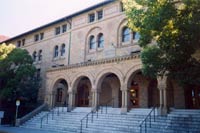view all Case Studies
Auditorium’s Lighting Retrofits Generate Applause

The University of Mary Washington recently upgraded its lighting system inside Dodd Auditorium as part of the university’s efforts to keep its vintage architectural spaces modern and functional
July 11, 2008 -
Lighting
The University of Mary Washington recently upgraded its lighting system inside Dodd Auditorium as part of the university’s efforts to keep its vintage architectural spaces modern and functional.
The auditorium on the Fredericksburg, Va., campus was built in the 1920s, and it is housed an inefficient, dimmable incandescent-lighting system that delivered very low light levels and created ongoing maintenance issues.
“Our objectives for the Dodd Auditorium were to increase energy efficiency, reduce maintenance requirements and obtain greater dimming abilities, while offering a lighting system that was more aesthetically-pleasing and flexible,” says Susan Knick, the university’s senior director of conference management.
The solution was a dimmable lighting system that includes 55-watt, compact fluorescent PL-L 950 high-light-output lamps from Philips Lighting, and Advance’s Mark 10® Powerline two-lamp electronic dimming ballasts.
With a 20,000-hour-rated average life, a color rendering index of 91, and a 5,000-Kelvin temperature rating, these lamps combine the long-life and energy-efficiency benefits of fluorescent technology with the pleasing appearance typically associated with incandescent lighting. The energy-efficient ballasts are versatile, flexible and easy to install because they require no additional wiring. With the ability to dim from 100 percent to 5 percent, the ballasts also provide the auditorium with the ability to adjust light levels for all events and activities.
“The new lamps and ballasts were fully compatible with the existing dimming system in the Dodd Auditorium such that we were able to reuse the facility’s dimmer banks and controls with only minor modifications and all of its branch circuit wiring without any changes,” says Bill Jennings, an electrical engineering consultant on the project.
The retrofits led to immediate results. The compact-fluorescent system has reduced energy consumption in the auditorium by up to 40 percent, while foot-candle levels increased from 5-10 to nearly 30.
Other design treatments, including repainting and redecorating the interior, have supported the new lighting strategy while helping further enhance the look and feel of this vintage space.
The retrofit has met all of its performance objectives and helped modernize an important campus structure and local landmark.
“We are extremely happy with the auditorium’s new lighting system,” Knick says. “It has elevated visibility within the space immeasurably and has allowed us to better respond to the needs of a wide range of audiences, including the elderly and end users with disabilities. Overall, the new lighting system has made the auditorium space feel so much more cheery and has helped draw attention to the many beautiful vintage elements in the room.
“Our whole technical staff is very satisfied with the upgrade, and we strongly encourage other institutions to consider this type of lighting system in their theaters based on its flexibility and appeal.”
Next
Read next on FacilitiesNet










